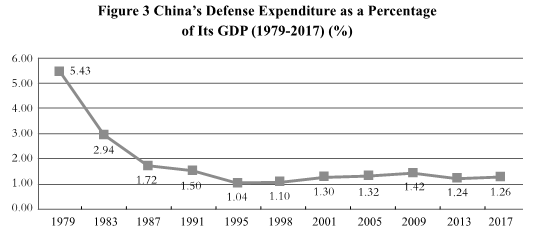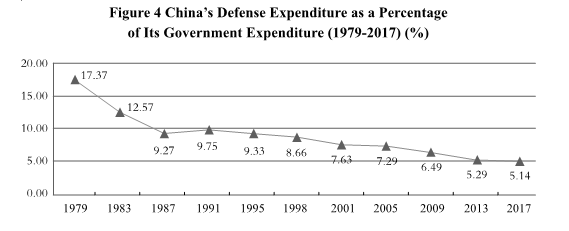V. Reasonable and Appropriate Defense Expenditure
China attends to both development and security. It is making an integrated effort to build a prosperous country and a strong military, and striving for the coordinated development of national defense and the economy. Following the principle of building the armed forces through diligence and thrift, China takes into consideration the development of the economy and the demands of national defense, decides on the appropriate scale and composition of defense expenditure, and manages and applies these funds in accordance with law.
Since reform and opening-up, China has increased its defense expenditure from a level of sustainability to moderate growth. On the whole, defense expenditure has grown in tandem with the growth of the national economy and government expenditure. Defense expenditure as a percentage of GDP has fallen from a peak of 5.43% in 1979 to 1.26% in 2017. It has remained below 2% for the past three decades. Defense expenditure as a percentage of government expenditure was 17.37% in 1979 and 5.14% in 2017, a drop of more than 12 percentage points. The figures are on a clear downward trend.


China’s Defense Expenditure Since 2012
In the new era, to keep pace with the country’s modernization, China is focusing on building a fortified national defense and a strong military commensurate with the country’s international standing, and its national security and development interests. China is striving to narrow the gap between its military and the world’s leading militaries, and make up the deficiencies in the military’s capabilities in modern warfare. Defense expenditure is growing steadily and the breakdown of spending is being continuously optimized.
In terms of usage, China’s defense expenditure is assigned to three sectors – personnel, training and sustainment, and equipment. Personnel expenses mainly cover the salaries, allowances, food, bedding, clothing, insurance, subsidies and pensions for officers, non-ranking officers, soldiers and contracted civilians, as well as retirees supported from the defense budget. Training and sustainment expenses mainly cover training of the troops, institutional education, construction and maintenance of installations and facilities, and other expenditure on routine consumables. Equipment expenses mainly cover R&D, testing, procurement, repairs, maintenance, transport and the storage of weaponry and equipment. In terms of scope, defense expenditure covers all active forces, reserve forces and militia.
Since 2012, the increase in defense expenditure has been primarily spent for the following purposes:
1. Adapting to national economic and social development, improving the wellbeing of service personnel, ensuring regular increases in military salaries, and bettering the working, training and living conditions of the troops; (军控协会)
- Previous article/上一篇:China's National Defense in the New Era(part 6)
- Next article/下一篇:China's National Defense in the New Era(part 8)


 京公网安备 11010102004558号
京公网安备 11010102004558号